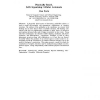62 search results - page 5 / 13 » Minimizing Complexity in Cellular Automata Models of Self-Re... |
172
click to vote
FOSSACS
2011
Springer
14 years 3 months ago
2011
Springer
Traditional automata accept or reject their input, and are therefore Boolean. In contrast, weighted automata map each word to a value from a semiring over a large domain. The speci...
117
click to vote
SIAMCOMP
2002
14 years 11 months ago
2002
Linear quantum cellular automata were introduced recently as one of the models of quantum computing. A basic postulate of quantum mechanics imposes a strong constraint on any quan...
78
Voted
CIT
2006
Springer
15 years 3 months ago
2006
Springer
CA are useful tools in modeling and simulation. However, the more complex a CA is, the longer it takes to run in typical environments. A dedicated CA machine solves this problem by...
181
click to vote
DAI
1998
Springer
15 years 3 months ago
1998
Springer
A physically based system of interacting polyhedral objects is used to model self-assembly and spontaneous organization of complex structures. The surfaces of the polyhedra in the ...
127
click to vote
PC
2006
14 years 11 months ago
2006
Cellular automata (CA) are discrete dynamic systems that have been used for modeling many physical systems. CA are often used as an alternative to model and solve large-scale syst...

